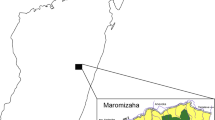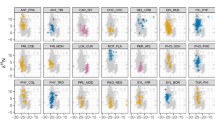Abstract
By comparing the isotopic composition of tissues deposited at different times, we can identify individuals that shift diets over time and individuals with constant diets. We define an individual as an isotopic specialist if tissues deposited at different times have similar isotopic composition. If tissues deposited at different times differ in isotopic composition we define an individual as an isotopic generalist. Individuals can be dietary generalists but isotopic specialists if they feed on the same resource mixture at all times. We assessed the degree of isotopic and dietary specialization in three related Chilean bird species that occupy coastal and/or freshwater environments: Cinclodes oustaleti, Cinclodes patagonicus, and Cinclodes nigrofumosus. C. oustaleti individuals were both isotopic and dietary generalists. Tissues deposited in winter (liver and muscle) had distinct stable C (δ13C) and stable N isotope ratio (δ15N) values from tissues deposited in the summer (wing feathers) suggesting that birds changed the resources that they used seasonally from freshwater habitats in the summer to coastal habitats in the winter. Although the magnitude of seasonal isotopic change was high, the direction of isotopic change varied little among individuals. C. patagonicus included both isotopic specialists and generalists, as well as dietary specialists and generalists. The isotopic composition of the feathers and liver of some C. patagonicus individuals was similar, whereas that of others differed. In C. patagonicus, there were large inter-individual differences in the magnitude and the direction of seasonal isotopic change. All individuals of C. nigrofumosus were both isotopic and dietary specialists. The distribution of δ13C and δ15N values overlapped broadly among tissues and clustered in a small, and distinctly intertidal, region of δ space. Assessing individual specialization and unraveling the factors that influence it, have been key questions in animal ecology for decades. Stable isotope analyses of several tissues in appropriate study systems provide an unparalleled opportunity to answer them.




Similar content being viewed by others
Explore related subjects
Discover the latest articles and news from researchers in related subjects, suggested using machine learning.References
Akamatsu F, Toda H, Okino T (2004) Food source of riparian spiders analyzed by using stable isotopes. Ecol Res 19:655–662
Araújo MS, Bolnick DI, Machado G, Giarreta AA, dos Reis SF (2007) Using δ13C stable isotopes to quantify individual-level diet variation. Oecologia 152:643–654
Bearhop S, Furness RW, Hilton G, Votier SC, Waldron S (2003) A forensic approach to understanding diet and habitat use from stable isotope analysis of (avian) claw material. Funct Ecol 17:270–275
Bearhop S, Adams CE, Waldron S, Fuller RA, Macleod H (2004) Determining trophic niche width: a novel approach using stable isotope analysis. J Anim Ecol 73:1007–1012
Bertolero A, Zavalaga C (2003) Observaciones sobre la biometría y la muda del churrete marisquero en Puerto San Juan, Costa Sur del Perú. Ornitol Neotrop 14:1–7
Bolnick DI, Svanback R, Fordyce JA, Yang LH, Davis JM, Hulsey CD, Forister ML (2003) The ecology of individuals: incidence and implications of individual specialization. Am Nat 161:1–28
Bolnick DI, Svanbäck R, Araújo MS, Persson L (2007) Comparative support for the niche variation hypothesis that more generalized populations are also more heterogeneous. Proc Natl Acad Sci 104:10075–10079
Carleton SA, Marínez del Rio C (2005) The effect of cold-induced increased metabolic rate on the rate of 13C and 15N incorporation in house sparrows (Passer domesticus). Oecologia 14:226–232
Carleton SA, Bakken BH, Martínez del Rio C (2006) Metabolic substrate use and the turnover of endogenous energy reserves in broad-tailed hummingbirds (Selasphorus platycercus). J Exp Biol 209:2622–2627
Carleton SA, Kelly L, Anderson-Sprecher R, Martínez del Rio C (2008) Should we use one, or multi-compartment models to describe 13C incorporation into animal tissues? Rapid Commun Mass Spec 22:3008–3014
Chase JM, Liebold MA (2003) Ecological niches: linking classical and contemporary approaches. University of Chicago Press, Chicago
Cherel Y, Le Corre M, Jaquemet S, Ménard Richard P, Weimerkirch H (2008) Resource partitioning within a tropical seabird community: new information from stable isotopes. Mar Ecol Prog Ser 366:281–291
Dalerum F, Angerbjörn A (2005) Resolving temporal variation in vertebrate diets using naturally occurring stable isotopes. Oecologia 144:647–658
Ehleringer JR, Rundel PW, Palma B, Mooney HA (1998) Carbon isotope ratios of Atacama Desert plants reflect hyperaridity of region. Rev Chil Hist Nat 71:79–86
Finlay JC (2001) Stable carbon isotope ratios of river biota: implications for energy flow in lotic food webs. Ecology 82:1052–1064
Finlay JC, Power ME, Cabana G (1999) Effects of water velocity on algal carbon isotope ratios: implications for river food web studies. Limnol Oceanog 44:1198–1203
Fox-Dobbs K, Bump JK, Peterson RO, Fox DL, Koch PL (2007) Carnivore-specific stable isotope variables and variation in the foraging ecology of modern and ancient wolf populations: case studies from Isle Royale, Minnesota, and La Brea. Can J Zool 85:458–471
Fry B (1991) Isotope diagrams of freshwater food webs. Ecology 72:2293–2297
Fry B (2006) Stable isotope ecology. Springer, New York
Goldstein DL, Skadhauge E (2000) Renal and extrarenal regulation of body fluid composition. In: Whittow GC (ed) Sturkey’s avian physiology. Academic Press, New York, pp 265–297
Herrera LG, Hobson KA, Martínez JC, Ménez CG (2006) Tracing the origin of dietary protein in tropical dry forest birds. Biotropica 38:735–742
Hobson KA, Clark RG (1992) Assessing avian diets using stable isotopes. I. Turnover of 13C in tissues. Condor 94:181–188
Holt RD, Barfield M, Gomulkiewicz R (2005) Theories of niche conservatism and evolution: could exotic species be potential tests? In: Sax DJ, Stachowicz J, Gaines SD (eds) Species invasions: insights into ecology, evolution, and biogeography. Sinauer, Sunderland, pp 259–290
Howland MR, Corr LT, Young SMM, Jones V, Jim S, Van Der Merwe NJ, Mitchell AD, Evershed RP (2003) Expression of the dietary isotope signal in the compound-specific δ13C values of pig bone lipids and amino acids. Int J Osteoarchaeol 13:54–65
Hutchinson GE (1957) Concluding remarks. Cold Spring Harbor Symp. Quant Biol 22:415–427
Jaramillo A (2003) Birds of Chile. Princeton University Press, Princeton
Johnson RA, Wichern DW (1998) Applied multivariate analysis. Prentice Hall, New York
Koch PL (2007) Isotopic study of the biology of modern and fossil vertebrates. In: Michener R, Lajtha K (eds) Stable isotopes in ecology and environmental science, 2nd edn. Blackwell, Boston, pp 99–154
Layman CA, Arrington DA, Montaña CG, Post DM (2007) Can stable isotope ratios provide for community-wide measures of trophic structure. Ecology 88:42–48
Martinez del Rio C, Wolf BO (2005) Mass-balance models for animal-isotopic ecology. In: Starck M, Wang T (eds) Physiological and ecological adaptations to feeding in vertebrates. Science Publishers, Enfield, pp 141–174
Martínez del Rio C, Wolf N, Carleton SA, Gannes LZ (2009) Isotopic ecology ten years after a call for more laboratory experiments. Biol Rev 84(1)91-111
Newsome S, Martínez del Rio C, Phillips DL, Bearhop S (2007) A niche for isotopic ecology. Front Ecol Environ 5:429–436
Norris DR, Marra PP, Kyser TK, Sherry TW, Ratcliffe TM (2004) Tropical winter habitat limits reproductive success on the temperate breeding grounds in a migratory bird. Proc R Soc Lond B 271:59–64
Norris DR, Marra PP, Kyser TK, Ratcliffe TM (2005) Tracking habitat use of a long-distance migratory bird, the American redstart Setophaga ruticilla, using stable-carbon isotopes in cellular blood. J Avian Biol 36:164–170
Raven JA, Johnston AM, Kübler JE, Korb B, McInroy SG, Scrimgeour CM, Walker DI, Beardall J, Varderklift M, Fredriksen S, Dunton KH (2002) Mechanistic interpretation of carbon isotope determination by marine macroalgae and seagrasses. Funct Plant Biol 29:355–378
Rubenstein DR, Hobson KA (2004) From birds to butterflies: animal movement patterns and stable isotopes. Trends Ecol Evol 19:256–263
Sabat P, Martínez del Rio C (2002) Inter- and intraspecific variation in the use of marine food resources by three Cinclodes (Furnariidae, Aves) species: carbon isotopes and osmoregulatory physiology. Zoology 105:247–256
Sabat P, Maldonado K, Rivera-Hutinel A, Farfan G (2004) Coping with salt without salt-glands: osmoregulatory plasticity in three species of coastal songbirds (ovenbirds) of the genus Cinclodes (Passeriformes: Furnariidae). J Comp Physiol B 174:415–420
Sabat P, Maldonado K, Canals M, Martínez del Rio C (2006a) Osmoregulation and adaptive radiation in the ovenbird genus Cinclodes (Passeriformes: Furnariidae). Funct Ecol 20:799–805
Sabat P, Maldonado K, Martínez del Rio C (2006b) Osmoregulatory capacity and the ability to use marine food sources in two coastal songbirds (Cinclodes: Furnariidae) along a latitudinal gradient. Oecologia 148:250–257
Schmidt SN, Olden JL, Solomon CT, Vander Zanden MJ (2007) Quantitative approaches to the analysis of stable isotope food-web data. Ecology 88:2793–2802
Soberón JM (2007) Grinnelian and Eltonian niches and geographic distribution of species. Ecol Lett 10:1115–1123
Vander Zanden MJ, Rasmussen JB (2001) Variation in δ15N and δ13C trophic fractionation: implications for aquatic food web studies. Limnol Ocean 46:2061–2066
Voigt CC, Rex K, Michener RH, Speakman J (in press) Nutrient routing in omnivorous animals tracked by stable isotopes in tissue and exhaled breath. Oecologia
Wang W, Yeh H (2003) δ13C values of marine macroalgae from Taiwan. Bot Bull Acad Sin 44:107–112
West JB, Bowen GJ, Cerling TE, Ehleringer JR (2006) Stable isotopes as one of nature’s recorders. Trends Ecol Evol 21:408–414
Wiens JJ, Graham CH (2005) Niche conservatism: integrating evolution, ecology, and conservation biology. Annu Rev Ecol Evol Syst 36:519–539
Zar JH (1996) Biostatistical analysis. Prentice Hall, Upper Saddle River
Acknowledgements
This work was financed by Fondo Nacional de Desarrollo Cientıfico y Tecnologico (Chile proyecto no. 1010647) to P. Sabat and an NSF grant to C. Martínez del Rio (IBN-0114016). We are thankful to Y. Cherel, K. Fox-Dobbs, S. Newsome, and two anonymous reviewers for constructive criticisms. C. Martínez del Rio and P. Sabat also thank R. E. Los Vascos for inspiration.
Author information
Authors and Affiliations
Corresponding author
Additional information
Communicated by Elisabeth Kalko.
Rights and permissions
About this article
Cite this article
Martínez del Rio, C., Sabat, P., Anderson-Sprecher, R. et al. Dietary and isotopic specialization: the isotopic niche of three Cinclodes ovenbirds. Oecologia 161, 149–159 (2009). https://doi.org/10.1007/s00442-009-1357-2
Received:
Accepted:
Published:
Issue Date:
DOI: https://doi.org/10.1007/s00442-009-1357-2




